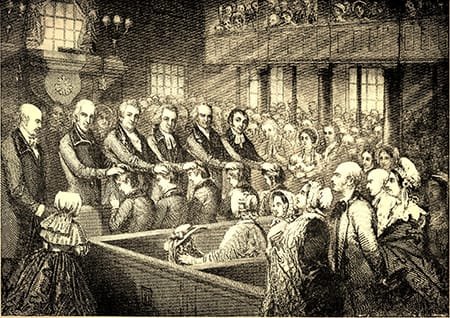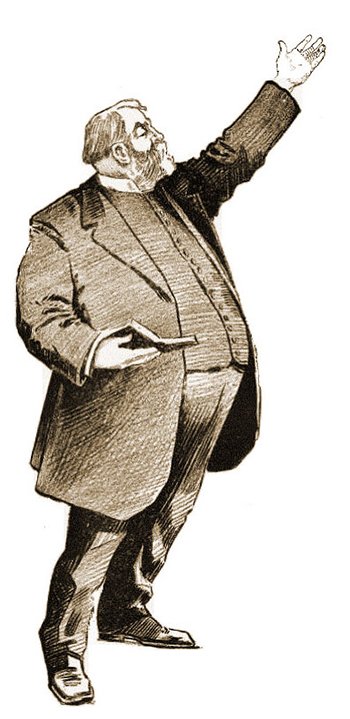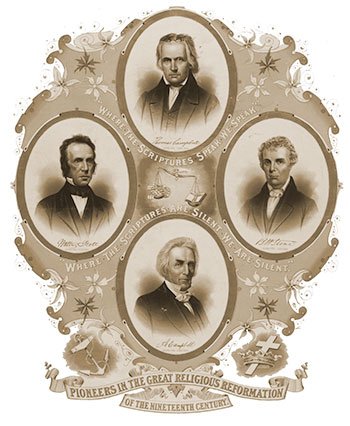The Haystack Revival of 1806

A facsimile of the 5 young students at the Haystack Prayer Meeting Centenary Celebrations.
This article looks into the history of this remarkable event, exploring its antecedents, key figures, impact, and lasting legacy.
Who could have believed that this small group’s meeting with God would be instrumental in sending 1,250 missionaries to various parts of the world. Thousands were saved, schools and hospitals were established, hospitals, the Bible was translated into numerous languages8 – all within the next 50 years! Read on for the full story.
Antecedents of the Haystack Revival
The Haystack Prayer Meeting didn’t occur in a vacuum. It was the culmination of various religious and social factors that had been brewing for years. The Second Great Awakening, a period of religious revivalism that swept through America in the late 18th and early 19th centuries, played a significant role in setting the stage for the Haystack Revival 1. This awakening emphasized personal religious experience, emotional preaching, and a focus on social reforms, including the abolition of slavery and the promotion of education 3. It was during this time that many began to feel a personal responsibility to share their faith and contribute to the betterment of society.
One of the key figures who influenced the students involved in the Haystack Prayer Meeting was William Carey, a British Baptist missionary who had published a pamphlet titled “An Enquiry into the Obligations of Christians to Use Means for the Conversion of the Heathen” 1. This pamphlet challenged Christians to actively engage in spreading the Gospel to all nations, a concept that resonated deeply with the young men at Williams College.
Furthermore, there was a growing awareness of missionary work being done in other parts of the world, particularly by the London Missionary Society, which had been formed in 1795 4. Reports of these missionary endeavours, along with the writings of theologians like Dr. Samuel Hopkins and Dr. Ezra Stiles, further fuelled the desire among some American Christians to engage in foreign missions.
The Haystack Prayer Meeting
On a sweltering Saturday afternoon in August 1806, five Williams College students – Samuel Mills, James Richards, Francis LeBaron Robbins, Harvey Loomis, and Byram Green – gathered for a prayer meeting in Sloan’s Meadow, a field north of the college campus 3. They had been meeting regularly for prayer and Bible study, often discussing Carey’s missionary manifesto and the spiritual needs of people in Asia 1.
As their discussion intensified, a sudden thunderstorm erupted, forcing them to seek shelter under a nearby haystack 3. Huddled together, they continued their conversation and began to pray fervently for the conversion of the heathen in Asia 3. It was during this impromptu prayer meeting that Samuel Mills, the leader of the group, declared with conviction, “We can do this, if we will!” 1. This statement, uttered amidst the raging storm, became a rallying cry for the nascent foreign missions movement in America.
Timeline of the Haystack Revival
| Date | Event | People Involved | Citation |
| August 1806 | Haystack Prayer Meeting | Samuel Mills, James Richards, Francis LeBaron Robbins, Harvey Loomis, and Byram Green | 3 |
| 1808 | Formation of “The Brethren” | Haystack Prayer group and other Williams students | 3 |
| 1810 | Formation of the American Board of Commissioners for Foreign Missions (ABCFM) | Congregationalists in Massachusetts | 3 |
| 1812 | ABCFM sends its first group of five missionaries to India | Adoniram Judson, Luther Rice, Samuel Newell, Samuel Nott, and Gordon Hall | 3 |
| 1819 | ABCFM sends first missionaries to the Near East and Hawaii | Various missionaries | 3 |
| 1832 | ABCFM sends first missionaries to China | Elijah Coleman Bridgman and others | 3 |
| 1867 | Erection of the Haystack Monument in Mission Park, Williamstown, Massachusetts | Byram Green and others | 3 |
| 1906 | Centennial gathering in Mission Park to celebrate the Haystack Prayer Meeting | 3 | |
| 2006 | Celebration of the 200th anniversary of the Haystack Prayer Meeting | Contemporary missioners | 3 |
Key Leaders of the Haystack Revival
While all five students played a role in the Haystack Prayer Meeting, Samuel Mills emerged as the driving force behind the movement. He was a passionate advocate for foreign missions and played a crucial role in the formation of several key organizations, including the American Board of Commissioners for Foreign Missions (ABCFM), the American Bible Society, and the United Foreign Missionary Society 7.
In 1808, the Haystack Prayer group, along with other students from Williams College, formed a society called “The Brethren.” 3 This group was dedicated to furthering the cause of missions and served as a precursor to the establishment of the ABCFM.
Mills’s commitment to spreading the Gospel extended beyond foreign missions. He also actively engaged in domestic missions, preaching in the Mississippi Valley and serving among the destitute in New York City 7. His tireless efforts and unwavering dedication to the Great Commission made him a pivotal figure in the development of American religion and culture.
The Significance of the Haystack
While there are no accounts of explicitly supernatural events associated with the Haystack Prayer Meeting, the circumstances surrounding the meeting were seen by many as providential. The sudden thunderstorm that drove the students to seek shelter under the haystack, the intensity of their prayer and discussion, and the subsequent formation of the ABCFM were interpreted as signs of God’s guidance and blessing 1.
The very image of these young men huddled together under a haystack, praying for the salvation of the world, became a powerful symbol of faith and dedication. It captured the imagination of Christians across America and inspired them to support the burgeoning ‘foreign missions movement.’ The “brevity of the shower, the strangeness of the place of refuge, and the peculiarity of their topic” all contributed to the impact of the meeting 3. The haystack itself became a symbol of God’s provision and the unexpected ways in which He works.
Lasting Impact of the Haystack Revival
The Haystack Prayer Meeting had a profound and lasting impact on American religion and culture. It marked the beginning of a concerted effort by American Protestants to send missionaries to foreign lands 8. Within four years of the meeting, the ABCFM was formed, and in 1812, the first American missionaries were sent to India 3. Among these early missionaries were Adoniram Judson and Luther Rice. Judson went on to become known as the “father of Baptist foreign missions,” playing a crucial role in establishing Baptist missionary work in Asia 1.
The ABCFM played a crucial role in shaping the American missionary movement. In its first fifty years, it sent out over 1,250 missionaries to various parts of the world, including China, Hawaii, and other nations in Southeast Asia 7. These missionaries not only preached the Gospel but also established schools, hospitals, and translated the Bible into numerous languages 8. One of the key figures who inspired the ABCFM to establish a mission in Hawaii was Henry Obookiah, a Hawaiian student who had come to America seeking education and spiritual guidance 9. His story touched the hearts of many and highlighted the need for missions to reach the Pacific islands.
The Haystack Revival also had a significant impact on the development of American Christianity. It fostered a sense of responsibility among American Christians for the spiritual welfare of people around the world 7. It also led to the formation of numerous other missionary organizations and fuelled the growth of various social reform movements 7.
However, the path to establishing the ABCFM was not without its challenges. When the students first proposed the formation of a missionary organization, they were met with scepticism and resistance from some church leaders. This highlights the courage and determination of these young men who persevered in their vision to see the Gospel spread to the nations.
The Haystack Prayer Meeting was not just a catalyst for American missions; it had a ripple effect that extended far beyond the borders of the United States. It marked the seedbed and pre-launch of the North American foreign mission movement, which has grown and influenced missions worldwide 10.
Historical Accounts and Documents
Several historical accounts and documents provide valuable insights into the Haystack Revival and its context. The Haystack Monument, erected in Mission Park in Williamstown, Massachusetts in 1867, stands as a testament to the significance of this event 2. The monument commemorates the five students who gathered under the haystack and their contribution to the birth of American foreign missions.
Williams College, where the Haystack Prayer Meeting took place, also preserves the history of this event through its archives and special collections 11. These resources offer valuable insights into the religious climate at Williams College during the early 19th century and the impact of the Haystack Revival on the college community.
Religious and Social Context
Religious Context
The Haystack Revival occurred during a period of significant religious and social change in America. The Second Great Awakening had sparked a renewed interest in religion and a desire for spiritual renewal 3. This religious fervour, combined with the growing influence of Enlightenment ideals, created a climate ripe for social reforms and missionary endeavours 12. The emphasis on personal religious experience and emotional preaching during the Second Great Awakening contributed to a sense of urgency and personal responsibility to share the Gospel with others.
Social Context
The early 19th century was also a time of westward expansion and increasing national identity in America. This sense of national purpose and the belief in America’s “manifest destiny” contributed to the growing support for foreign missions, as some Christians saw it as their duty to spread their faith and values to other parts of the world 1. The social and political changes of the time created an environment where individuals felt empowered to make a difference in the world, both at home and abroad.
Other Revivals of the Era
The Haystack Revival was not an isolated event. It was part of a larger wave of religious revivals that swept through America during the Second Great Awakening. Some of the other notable revivals of this era include:
- The Cane Ridge Revival (1801): This revival, which took place in Kentucky, was one of the largest and most influential camp meetings of the Second Great Awakening. It is estimated that between 10,000 and 25,000 people attended this revival, which featured emotional preaching, fervent prayer, and numerous conversions. The Cane Ridge Revival is considered a significant event in the history of the Stone-Campbell Restoration Movement and contributed to the growth of various denominations, including the Disciples of Christ and the Churches of Christ.
- The Yale Revival (1802): This revival, led by Yale College president Timothy Dwight, marked a turning point in the religious climate at Yale and other New England colleges. It led to a renewed emphasis on evangelical Christianity and a surge in student interest in missions and social reforms. The Yale Revival played a crucial role in countering the influence of Enlightenment skepticism and reaffirming the importance of faith and religious commitment in higher education.
- The Rochester Revival (1830-1831): This revival, led by evangelist Charles Finney, was characterized by its emphasis on personal conversion and social activism. It had a significant impact on the development of the abolitionist movement and other social reforms. Finney’s “new measures,” which included protracted meetings, public invitations to come forward for prayer, and the “anxious bench,” became widely adopted by other evangelists and contributed to the spread of revivalism throughout the country.
Comparison with Other Revivals
While the Haystack Revival shared some similarities with other revivals of the Second Great Awakening, it also had some unique characteristics. Unlike the large camp meetings that characterized many revivals, the Haystack Prayer Meeting was a small, intimate gathering. It was also unique in its focus on foreign missions, a concept that was relatively new to American Protestantism at the time 3.
Furthermore, the Haystack Revival had a more direct and lasting impact on the development of organized missionary activity in America. It led to the formation of the ABCFM, which became the primary vehicle for American Protestant missions throughout the 19th century 8. The Haystack Revival also stands out for its emphasis on prayer and the role of individual agency in fulfilling the Great Commission 10. It demonstrated that even a small group of dedicated individuals, driven by prayer and a commitment to God’s call, could spark a movement that would change the course of history.
Significance of the Haystack Revival
The Haystack Revival holds a significant place in American religious history. It marked a turning point in the development of American Protestantism, shifting the focus from domestic missions to a global perspective 8. It also played a crucial role in shaping American culture, fostering a sense of responsibility for the welfare of people around the world and contributing to the growth of various social reform movements 3.
The legacy of the Haystack Revival continues to inspire Christians today. It serves as a reminder of the power of prayer, the importance of foreign missions, and the potential for even small groups of individuals to make a significant impact on the world 6. The Haystack Revival demonstrates that God can use ordinary people in extraordinary ways to accomplish His purposes.
Conclusion
The Haystack Revival of 1806 was a pivotal moment in American religious history. It ignited a passion for foreign missions that spread throughout the nation and led to the formation of the first American missionary organization. This seemingly insignificant gathering of five college students under a haystack had a profound and lasting impact on American religion and culture, shaping the course of American Protestantism and inspiring generations of Christians to engage in global missions.
The legacy of the Haystack Revival continues to this day, reminding us of the power of prayer, the importance of global engagement, and the potential for even small groups of individuals to make a significant difference in the world. It challenges us to consider our own role in fulfilling the Great Commission and to embrace the vision of these young men who, huddled together under a haystack, dared to believe that they could change the world. Their story serves as an inspiration and a call to action for all Christians to actively participate in God’s mission to reach the nations with the Gospel.
Works cited
- Haystack Prayer: “We Can Do This, If We Will” | Baptist Press, accessed on January 29, 2025, https://www.baptistpress.com/resource-library/sbc-life-articles/haystack-prayer-we-can-do-this-if-we-will/
- Mission Park – Special Collections – Williams College, accessed on January 29, 2025, https://specialcollections.williams.edu/williams-history/buildings/mission-park/
- Haystack Prayer Meeting – Wikipedia, accessed on January 29, 2025, https://en.wikipedia.org/wiki/Haystack_Prayer_Meeting
- Haystack Prayer Meeting : an account of its origin and Spirit – Internet Archive, accessed on January 29, 2025, https://ia800704.us.archive.org/5/items/haystackprayerme00unse/haystackprayerme00unse.pdf
- The Haystack Prayer Meeting – Global Ministries, accessed on January 29, 2025, https://www.globalministries.org/resource/what_is_haystack/
- Haystack Prayer Meeting – The Traveling Team, accessed on January 29, 2025, https://www.thetravelingteam.org/articles/haystack-prayer-meeting
- What was the Haystack Prayer Meeting? | GotQuestions.org, accessed on January 29, 2025, https://www.gotquestions.org/Haystack-Prayer-Meeting.html
- The History of the Haystack Prayer Meeting – Global Ministries, accessed on January 29, 2025, https://www.globalministries.org/the_history_of_the_haystack_pray_10_10_2014_112/
- Haystack Prayer Meeting | Images of Old Hawaiʻi, accessed on January 29, 2025, https://imagesofoldhawaii.com/haystack-prayer-meeting/
- Why the Haystack Prayer Meeting Matters Today | Missio Nexus, accessed on January 29, 2025, https://missionexus.org/haystack-prayer-meeting-matters-today/
- The Haystack, Mission Park, and Institutional Histories – Williams Libraries, accessed on January 29, 2025, https://library.williams.edu/2018/09/08/the-haystack-mission-park-and-institutional-histories/
- Glimpsing Revival: The Haystack Prayer Meeting – How a Campus Revival Birthed American Foreign Missions – EquippingSaints.com, accessed on January 29, 2025, https://equippingsaints.com/2018/08/09/the-haystack-prayer-meeting-how-a-campus-revival-birthed-american-foreign-missions/



